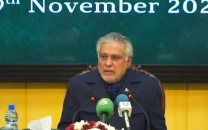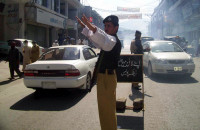Master of murals: The life and times of Arbab Muhammad Sardar Khan
The artists’ favourite canvas is stone walls while the desired subject matter of his paintings is nature and...

The artist’s only regret is that his earlier work on Peshawar’s historical sites has withered away due to official negligence. PHOTOS: EXPRESS
Painter, sculptor and calligrapher Arbab Muhammad Sardar Khan is well known the world over but is almost a stranger to his own people.
He has to-date created several hundred paintings, sculptures and relief murals, most of which are scattered all over his house while some are displayed at art centres around the country.

The artist’s favourite canvas is stone walls while the desired subject matter of his paintings is nature and heritage. His taste for all things culture is reflected on the beautifully decorated walls, windows and doors of his house which also serves as one of the most diverse private art galleries of the province. This, apart from being a source of inspiration for budding artists, holds immense historical importance.
Another interesting aspect of Khan’s paintings is their depiction of nature, with scenic landscapes, scenes of bustling bazaars, birds, flowers, foliage and portraits of both men and women standing out regularly. It is for this particular aspect that the artist was awarded the president’s pride of performance award.
“We are far behind in arts and architecture compared to the rest of the world. We are still living in ancient times,” Khan said, while talking to The Express Tribune. “There is some sort of supervision of arts in the rest of the country but in Khyber-Pakhtunkhwa (K-P), nobody cares much for preserving and promoting art, culture, heritage and architecture.”
The artist was associated with the Abasin Arts Council for a long time, which now exists as a cultural centre only on paper. “The most important thing for promotion of arts in the province is to open art galleries,” said Khan. He regretted that K-P has very few art galleries and no proper institutions or teachers to teach art to those still interested in this field.

Khan learned the art of sculpting and became engrossed with marble architecture and stone during his time at a professional art academy in Carrara, Italy in the 1980’s. He also mastered modern techniques of painting during the time, which he then imparted on to students.
A careful glance at some of Khan’s paintings, mostly oil and charcoal, reveals their connection to realism where the ancient bazaar of Qissa Khwani, the historical Mohabbat Khan mosque, the vibrant Khattak dance and the Khyber Pass, among others, come to life.
“I was not inspired by anyone in particular and mostly developed my own style,” he said, adding for him the perfect artist is the one who can perfectly describe a region’s culture and heritage to the next generation.”
Khan’s paintings are exhibited at the High Commission for Pakistan in London, the Governor House in Peshawar, army’s artillery mess in Nowshera, the chief minister’s office in Peshawar, the National Assembly, the Pakistani embassy in Berlin and at the Ministry of Foreign Affairs.
While Khan’s large murals are all around the province, the most prominent ones are located at Risalpur, Attock Bridge and Peshawar’s Jinnah Park.
He said these murals are the product of a long thinking process and hard work stretching to several months, from the initial sketches and the enlargement process to clay models and the then the final shape.
The artist’s only regret is that his earlier work on Peshawar’s historical sites has withered away due to official negligence and all that is left are his paintings, stored safely in his house. The artist’s house is full of his paintings, sculptures and relief murals which too are slowly rusting away as he is unable to store them properly.
Khan has requested authorities to establish a place where he can preserve and display his artwork and rest assured that it is safe for the coming generations to observe and learn from.
Published in The Express Tribune, February 10th, 2014.





1729471601-0/image-(8)1729471601-0-208x130.webp)







COMMENTS
Comments are moderated and generally will be posted if they are on-topic and not abusive.
For more information, please see our Comments FAQ